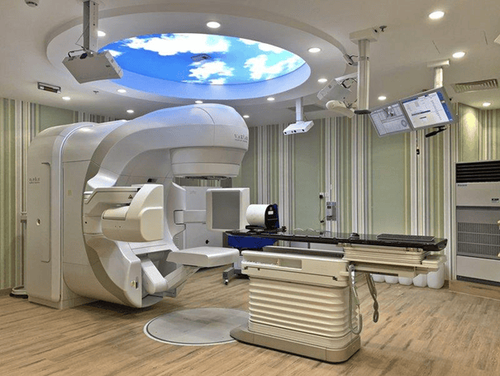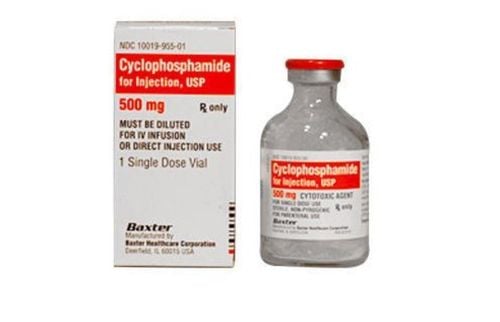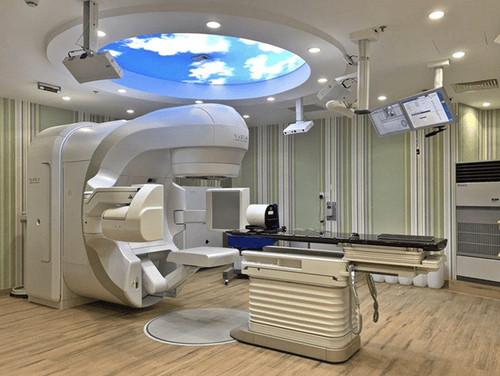This is an automatically translated article.
The article was professionally consulted by Specialist Doctor II Bui Le Phuoc Thu Thao - Radiotherapy Doctor - Oncology Center - Vinmec Central Park International General Hospital.
Radiation therapy is a cancer treatment that uses beams of ionizing radiation to kill cancer cells so that they can treat tumors or shrink tumors. At low doses, this type of radiation is present in X-rays when certain diagnostic imaging tests are performed, such as X-rays and computed tomography scans.
1. Radiation therapy and cancer
Radiation therapy can cure cancers, stop them from coming back, or slow tumor growth. Radiation therapy is also indicated in some cases when it is necessary to relieve symptoms caused by cancer such as bleeding, pressure, pain.
Technically, radiation therapy can be divided into:
External beam radiation therapy: the source of radiation is placed outside the patient, emitting beams to the tumor.
Brachytherapy (also called internal radiation therapy): the source of radiation is brought close to the tumor, which can be applied to the surface of the tumor (eg, radiation therapy for skin cancer, cervical cancer) ) or injected through the tissue into the tumor core (eg, radiation therapy for some oral cancers, prostate cancer)
Radiopharmaceuticals: radioactive isotopes that are introduced into the patient's body (by orally or by injection) delivers radiation to cancer cells (eg, treating thyroid cancer with Iodine 131 or treating pain with the radioactive drug Samarium)
At high doses, radiation therapy kills or suppresses inhibit the growth of cancer cells by damaging their DNA. When DNA is damaged, cancer cells either stop dividing or are broken down and eliminated from the body.
Radiation therapy cannot kill cancer cells immediately. As a result, it takes patients days or weeks of treatment to get enough time to damage DNA and kill cancer cells. After the end of radiation therapy, the cancer cells continue to die for several more weeks or months.
2. Radiotherapy methods
There are two main types of radiation therapy: external beam radiation therapy and internal radiation therapy. The choice of radiation therapy method should be based on many factors, including:
The type of cancer The size of the tumor The location of the tumor in the body The distance of the tumor from the nearby healthy organs. Patient's health status and medical history Other cancer treatments are available Patient's age and other factors 2.1. External beam radiation therapy External beam radiation therapy is radiation therapy that sends a beam of radiation from outside the patient's body to a tumor located in the patient's body. Normally, the patient will be fixed on the radiotherapy table, fixed tools can be used to ensure the stability of the patient while the machine is emitting rays. The radiation machine will move around the patient's location. In some modern radiotherapy machines, the machine will simultaneously emit radiation while moving to optimize dose distribution, and save patient treatment time.

External radiation therapy is a local treatment, only localized radiation therapy to the primary tumor, metastatic lymph nodes and nearby areas with high risk of tumor spread. For example, if the patient has cancer in the lung, the indication for radiation therapy will be localized to the lung tumor, the group of metastatic nodes, and the high-risk regional lymph nodes for metastasis.
2.2. Brachytherapy Brachytherapy: also known as internal radiation therapy, near-radiotherapy is treatment by placing a radioactive source, either solid or liquid, inside the patient's body to get close to the patient. tumor site to be irradiated.
Solid source: Radioactive sources in the form of tubes, needles, fibers, beads or thin sheets are placed near the tumor or penetrated into the tumor tissue and placed inside the tumor. Similar to external beam radiation therapy, this is a local treatment and affects only a certain part of the patient's body.
Liquid source: This form of internal radiation therapy with a liquid radioactive source is called radiopharmaceutical therapy and has systemic effects. That's because radiation travels through the bloodstream to tissues throughout the patient's body, where it searches for and destroys cancer cells. Patients receive systemic radiation therapy by swallowing, IV infusion, or by injecting a liquid radioactive source into the body. The patient then gives off radiation through urine, sweat, and saliva for a while.
3. Types of cancer treated with radiation therapy
External beam radiation therapy is used to treat many types of cancer. Brachytherapy is often used for head and neck cancer, breast cancer, cervical cancer, prostate cancer, and some skin cancers. Systemic radiation therapy (radioactive iodine, I-131) is common in the treatment of some types of thyroid cancer. Molecular (systemic) radiation therapy, called targeted radionuclide therapy, is given to patients with prostate cancer or gastrointestinal neuroendocrine tumors (GEP-NET). See also: Evaluation of the results of two years of chemoradiotherapy and the use of Vmat technique in the radical treatment of some head and neck cancers
4. Combined radiation therapy
Radiation therapy is a weapon in the treatment of cancer. Often, when treating cancer, it is necessary to combine many different therapeutic weapons, called multimodal treatment. There are still cases of patients requiring a single treatment, often in early-stage cancers, where treatment is simpler and less expensive. However, most patients require a combination of treatment modalities to increase control of the disease, increase the chance of cure, and prolong survival. In addition to radiation therapy, the main modes of cancer treatment are surgery, chemotherapy, and immunotherapy. Radiation therapy can be given before, during, or after other treatments to improve the chances of a cure. The timing of radiation therapy also depends on the type of cancer as well as whether the goal is to cure the disease or limit symptoms.
If radiation therapy is combined with surgery, the possible cases are:
Before surgery: With the effect of reducing the size of the tumor so that it is easy to remove completely by surgery and less likely to recurrence potential. During surgery: Intraoperative radiotherapy uses radiation to go directly to cancer cells without going through the skin, helping to protect nearby healthy tissue from radiation. After surgery: To destroy microscopic cancer cells that are not visible during surgery.

5. Some other notes
5.1. Radiation Dose Limits Each of the above areas may have a different limit on the amount of radiation that can be irradiated, and patients need to adhere to that standard for safety. If the limit for an area has been reached, no further treatment should be given, or irradiation in another area of the body must be ensured to ensure a safe dose limit for organs in the previously irradiated area
5.2. Side effects of radiation therapy Radiation not only kills or slows the growth of cancer cells, but can also affect surrounding healthy cells. Damage to healthy cells or tissues can cause different side effects.
5.3. The cost of radiation therapy The cost of radiation therapy will be quite high because this technique requires the use of complex machines. The exact total fee depends on the health care service the patient chooses, the type of radiation therapy, and the number of treatments they need.
5.4. Diet during radiation therapy Radiation can cause side effects that make it difficult to eat, nausea, mouth sores or esophagitis. Because the body must expend a lot of energy to recover during radiation therapy, it is important for patients to consume enough calories and protein to maintain their weight and health.
5.5. Working during radiation therapy Some people can work full-time during radiation therapy. Others may only work part-time or take a complete break. Whether to go to work while undergoing radiation therapy or not depends on the condition and condition of each patient.
Sometimes people feel quite well after the first radiation treatment. But then they get more tired, lose energy, and get weaker. Patients do not need to worry too much because after finishing the treatment, it only takes a few weeks or months for them to return to normal.
6. Radiotherapy program at Vinmec Central Park
The strength of Vinmec Central Park International Oncology Center is the state-of-the-art equipment, using the most modern Truebeam radiotherapy machine in Southeast Asia, helping the SRS technique here achieve more optimal results.
In addition, a team of experienced and highly qualified doctors and specialists: Doctor Nguyen Duy Sinh, Doctor Le Tan Dat, Doctor Phung Thi Phuong Chi, Doctor Nong Ngoc Son, Doctor Do Tuong Huan
... always strive to accompany cancer patients in Vietnam. With leading experience in the industry, the medical experts at Vinmec Central Park have been careful right from the diagnosis stage, choosing the most appropriate treatment regimen as well as coordinated treatment, multi-specialty approach, contributing to the care of patients. comprehensive and optimal disease.
Outpatient clinic and inpatient hospital with international 5-star standards invested and built at Vinmec Central Park Oncology Department not only bring high treatment efficiency, but also bring absolute comfort. patients at a reasonable cost. Because Vinmec understands that psychological factors, optimism plays a key role on the way to fight cancer of customers.
Specialist II Bui Le Phuoc Thu Thao has nearly 15 years of experience in direct treatment of cancer patients, especially radiation oncology and care for terminal cancer patients, palliative care mild and pain-relieving. Dr. Thao has participated in many advanced training courses at home and abroad such as advanced radiation therapy in Singapore and Korea, and the National Palliative Care Instructor training course of Harvard University. Currently, Dr. Thao is working at the Center for Cancer - Radiation Therapy, Vinmec Central Park International General Hospital.
Please dial HOTLINE for more information or register for an appointment HERE. Download MyVinmec app to make appointments faster and to manage your bookings easily.
References: Cancer.gov














